Organisational Behavior: Social Media Analysis of Job Candidates
VerifiedAdded on 2021/04/16
|5
|1081
|266
Report
AI Summary
This report analyzes the use of social media in the context of organisational behavior, specifically focusing on candidate selection. The report presents three scenarios: asking candidates for permission to view their social media, viewing their profiles without their knowledge, and not looking at their profiles at all. Each scenario is evaluated based on its advantages and disadvantages, considering factors such as transparency, privacy, potential for misjudgment, and equality. The author concludes by outlining their preferred approach, which involves obtaining candidate permission, reviewing profiles on platforms like Facebook, LinkedIn, and Twitter, and asking follow-up questions about their posts and engagement. The author emphasizes the importance of candidate activity and diversification across platforms as indicators of social media proficiency and suitability for social media marketing roles. The report references several academic sources to support its arguments.
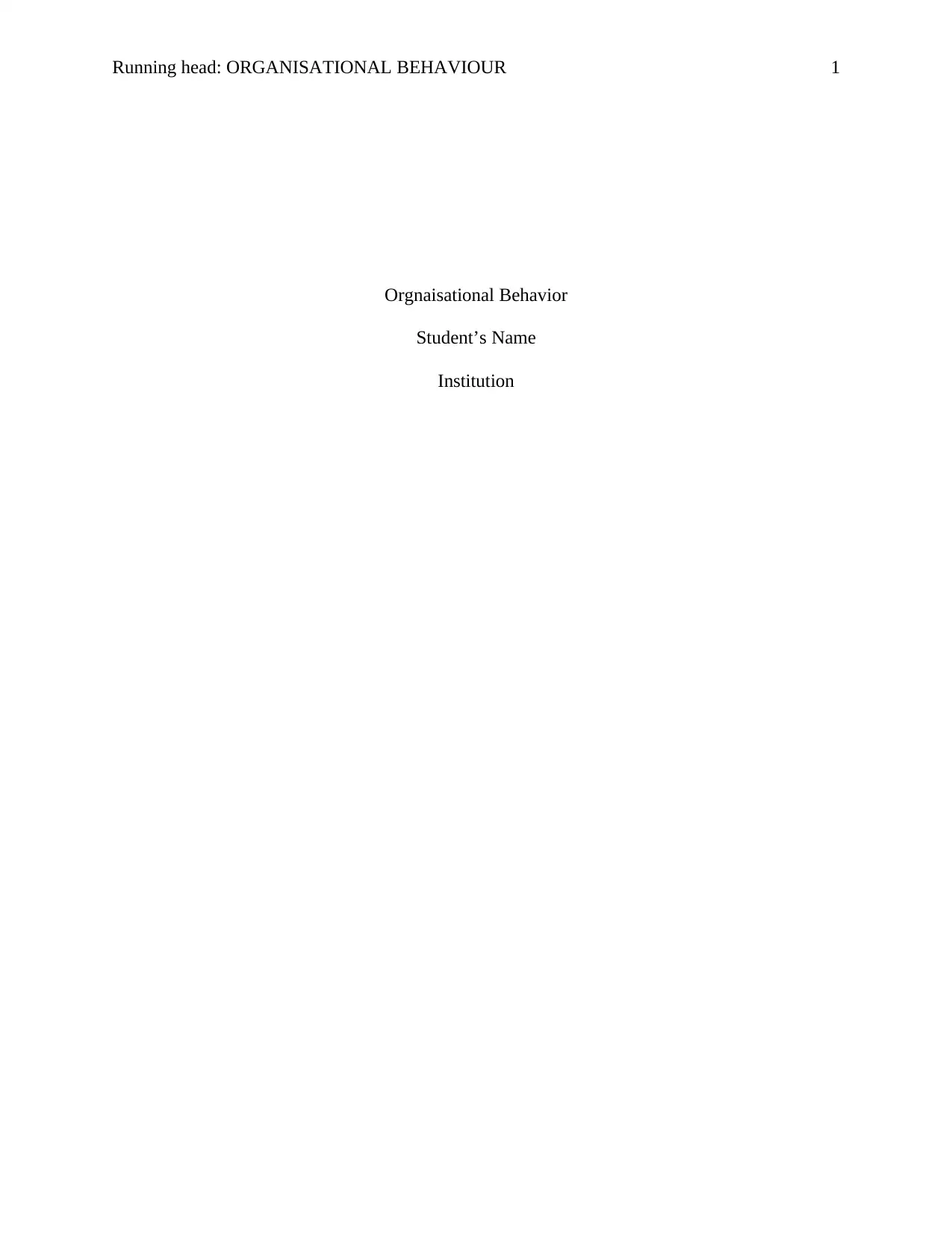
Running head: ORGANISATIONAL BEHAVIOUR 1
Orgnaisational Behavior
Student’s Name
Institution
Orgnaisational Behavior
Student’s Name
Institution
Paraphrase This Document
Need a fresh take? Get an instant paraphrase of this document with our AI Paraphraser
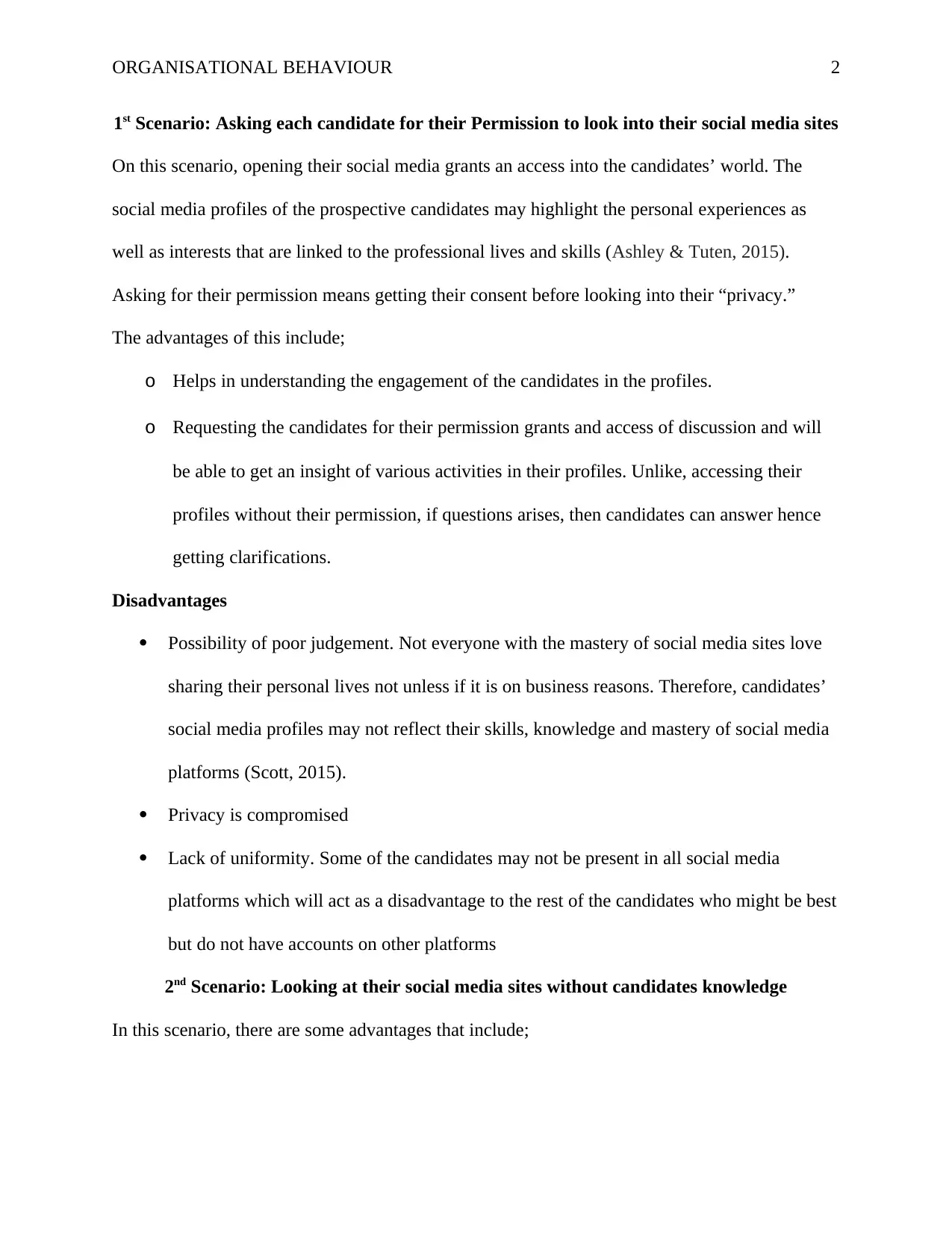
ORGANISATIONAL BEHAVIOUR 2
1st Scenario: Asking each candidate for their Permission to look into their social media sites
On this scenario, opening their social media grants an access into the candidates’ world. The
social media profiles of the prospective candidates may highlight the personal experiences as
well as interests that are linked to the professional lives and skills (Ashley & Tuten, 2015).
Asking for their permission means getting their consent before looking into their “privacy.”
The advantages of this include;
o Helps in understanding the engagement of the candidates in the profiles.
o Requesting the candidates for their permission grants and access of discussion and will
be able to get an insight of various activities in their profiles. Unlike, accessing their
profiles without their permission, if questions arises, then candidates can answer hence
getting clarifications.
Disadvantages
Possibility of poor judgement. Not everyone with the mastery of social media sites love
sharing their personal lives not unless if it is on business reasons. Therefore, candidates’
social media profiles may not reflect their skills, knowledge and mastery of social media
platforms (Scott, 2015).
Privacy is compromised
Lack of uniformity. Some of the candidates may not be present in all social media
platforms which will act as a disadvantage to the rest of the candidates who might be best
but do not have accounts on other platforms
2nd Scenario: Looking at their social media sites without candidates knowledge
In this scenario, there are some advantages that include;
1st Scenario: Asking each candidate for their Permission to look into their social media sites
On this scenario, opening their social media grants an access into the candidates’ world. The
social media profiles of the prospective candidates may highlight the personal experiences as
well as interests that are linked to the professional lives and skills (Ashley & Tuten, 2015).
Asking for their permission means getting their consent before looking into their “privacy.”
The advantages of this include;
o Helps in understanding the engagement of the candidates in the profiles.
o Requesting the candidates for their permission grants and access of discussion and will
be able to get an insight of various activities in their profiles. Unlike, accessing their
profiles without their permission, if questions arises, then candidates can answer hence
getting clarifications.
Disadvantages
Possibility of poor judgement. Not everyone with the mastery of social media sites love
sharing their personal lives not unless if it is on business reasons. Therefore, candidates’
social media profiles may not reflect their skills, knowledge and mastery of social media
platforms (Scott, 2015).
Privacy is compromised
Lack of uniformity. Some of the candidates may not be present in all social media
platforms which will act as a disadvantage to the rest of the candidates who might be best
but do not have accounts on other platforms
2nd Scenario: Looking at their social media sites without candidates knowledge
In this scenario, there are some advantages that include;
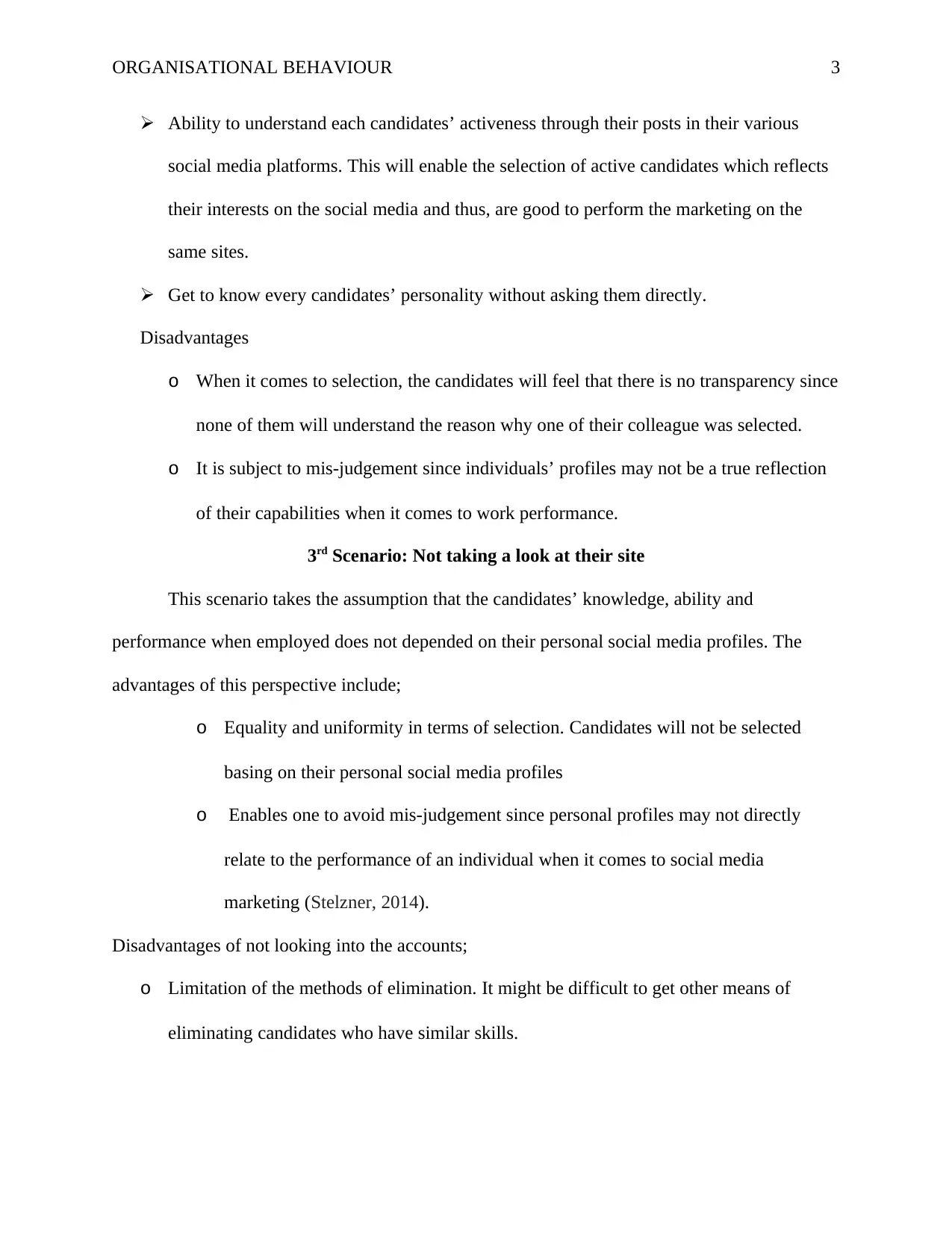
ORGANISATIONAL BEHAVIOUR 3
Ability to understand each candidates’ activeness through their posts in their various
social media platforms. This will enable the selection of active candidates which reflects
their interests on the social media and thus, are good to perform the marketing on the
same sites.
Get to know every candidates’ personality without asking them directly.
Disadvantages
o When it comes to selection, the candidates will feel that there is no transparency since
none of them will understand the reason why one of their colleague was selected.
o It is subject to mis-judgement since individuals’ profiles may not be a true reflection
of their capabilities when it comes to work performance.
3rd Scenario: Not taking a look at their site
This scenario takes the assumption that the candidates’ knowledge, ability and
performance when employed does not depended on their personal social media profiles. The
advantages of this perspective include;
o Equality and uniformity in terms of selection. Candidates will not be selected
basing on their personal social media profiles
o Enables one to avoid mis-judgement since personal profiles may not directly
relate to the performance of an individual when it comes to social media
marketing (Stelzner, 2014).
Disadvantages of not looking into the accounts;
o Limitation of the methods of elimination. It might be difficult to get other means of
eliminating candidates who have similar skills.
Ability to understand each candidates’ activeness through their posts in their various
social media platforms. This will enable the selection of active candidates which reflects
their interests on the social media and thus, are good to perform the marketing on the
same sites.
Get to know every candidates’ personality without asking them directly.
Disadvantages
o When it comes to selection, the candidates will feel that there is no transparency since
none of them will understand the reason why one of their colleague was selected.
o It is subject to mis-judgement since individuals’ profiles may not be a true reflection
of their capabilities when it comes to work performance.
3rd Scenario: Not taking a look at their site
This scenario takes the assumption that the candidates’ knowledge, ability and
performance when employed does not depended on their personal social media profiles. The
advantages of this perspective include;
o Equality and uniformity in terms of selection. Candidates will not be selected
basing on their personal social media profiles
o Enables one to avoid mis-judgement since personal profiles may not directly
relate to the performance of an individual when it comes to social media
marketing (Stelzner, 2014).
Disadvantages of not looking into the accounts;
o Limitation of the methods of elimination. It might be difficult to get other means of
eliminating candidates who have similar skills.
⊘ This is a preview!⊘
Do you want full access?
Subscribe today to unlock all pages.

Trusted by 1+ million students worldwide
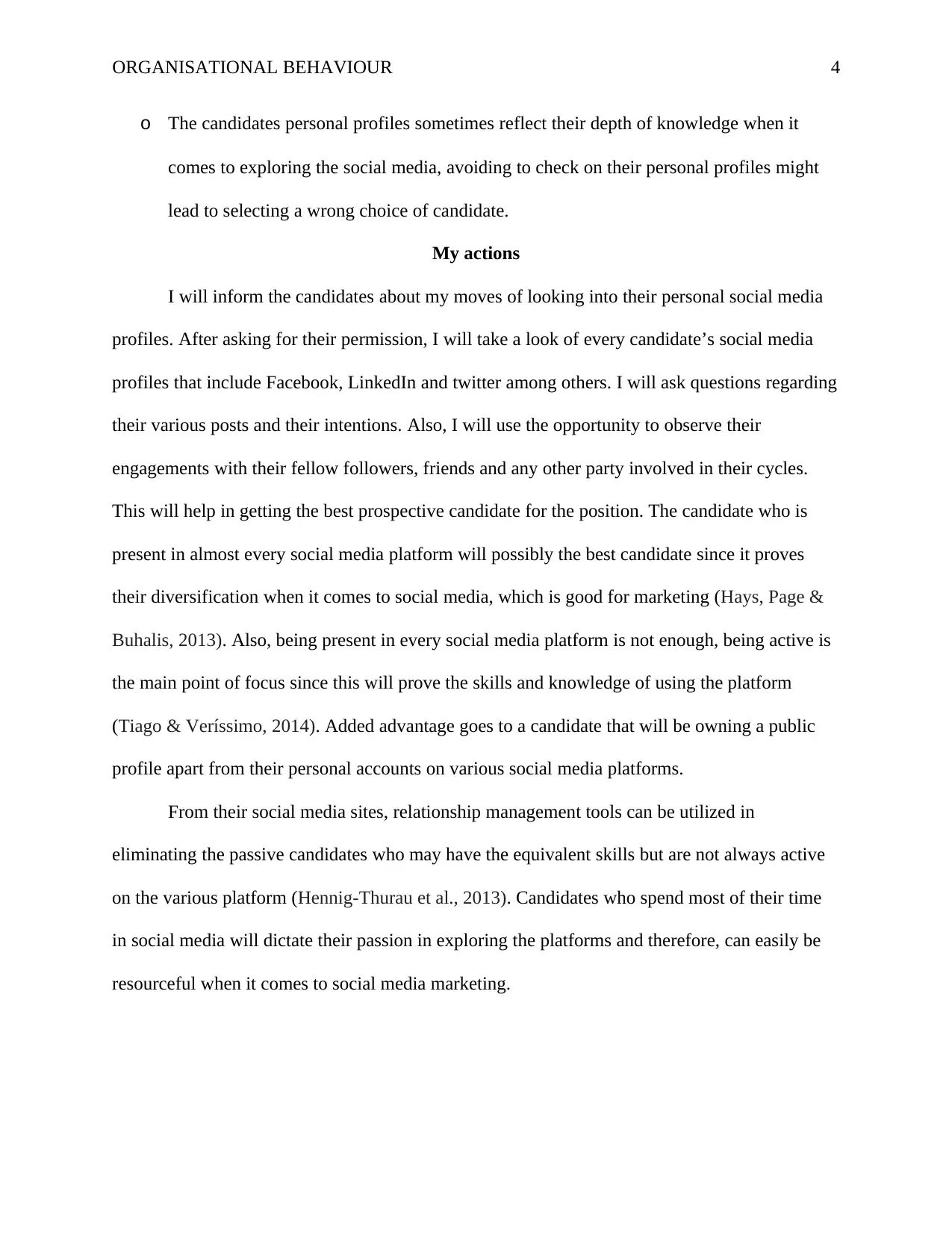
ORGANISATIONAL BEHAVIOUR 4
o The candidates personal profiles sometimes reflect their depth of knowledge when it
comes to exploring the social media, avoiding to check on their personal profiles might
lead to selecting a wrong choice of candidate.
My actions
I will inform the candidates about my moves of looking into their personal social media
profiles. After asking for their permission, I will take a look of every candidate’s social media
profiles that include Facebook, LinkedIn and twitter among others. I will ask questions regarding
their various posts and their intentions. Also, I will use the opportunity to observe their
engagements with their fellow followers, friends and any other party involved in their cycles.
This will help in getting the best prospective candidate for the position. The candidate who is
present in almost every social media platform will possibly the best candidate since it proves
their diversification when it comes to social media, which is good for marketing (Hays, Page &
Buhalis, 2013). Also, being present in every social media platform is not enough, being active is
the main point of focus since this will prove the skills and knowledge of using the platform
(Tiago & Veríssimo, 2014). Added advantage goes to a candidate that will be owning a public
profile apart from their personal accounts on various social media platforms.
From their social media sites, relationship management tools can be utilized in
eliminating the passive candidates who may have the equivalent skills but are not always active
on the various platform (Hennig-Thurau et al., 2013). Candidates who spend most of their time
in social media will dictate their passion in exploring the platforms and therefore, can easily be
resourceful when it comes to social media marketing.
o The candidates personal profiles sometimes reflect their depth of knowledge when it
comes to exploring the social media, avoiding to check on their personal profiles might
lead to selecting a wrong choice of candidate.
My actions
I will inform the candidates about my moves of looking into their personal social media
profiles. After asking for their permission, I will take a look of every candidate’s social media
profiles that include Facebook, LinkedIn and twitter among others. I will ask questions regarding
their various posts and their intentions. Also, I will use the opportunity to observe their
engagements with their fellow followers, friends and any other party involved in their cycles.
This will help in getting the best prospective candidate for the position. The candidate who is
present in almost every social media platform will possibly the best candidate since it proves
their diversification when it comes to social media, which is good for marketing (Hays, Page &
Buhalis, 2013). Also, being present in every social media platform is not enough, being active is
the main point of focus since this will prove the skills and knowledge of using the platform
(Tiago & Veríssimo, 2014). Added advantage goes to a candidate that will be owning a public
profile apart from their personal accounts on various social media platforms.
From their social media sites, relationship management tools can be utilized in
eliminating the passive candidates who may have the equivalent skills but are not always active
on the various platform (Hennig-Thurau et al., 2013). Candidates who spend most of their time
in social media will dictate their passion in exploring the platforms and therefore, can easily be
resourceful when it comes to social media marketing.
Paraphrase This Document
Need a fresh take? Get an instant paraphrase of this document with our AI Paraphraser
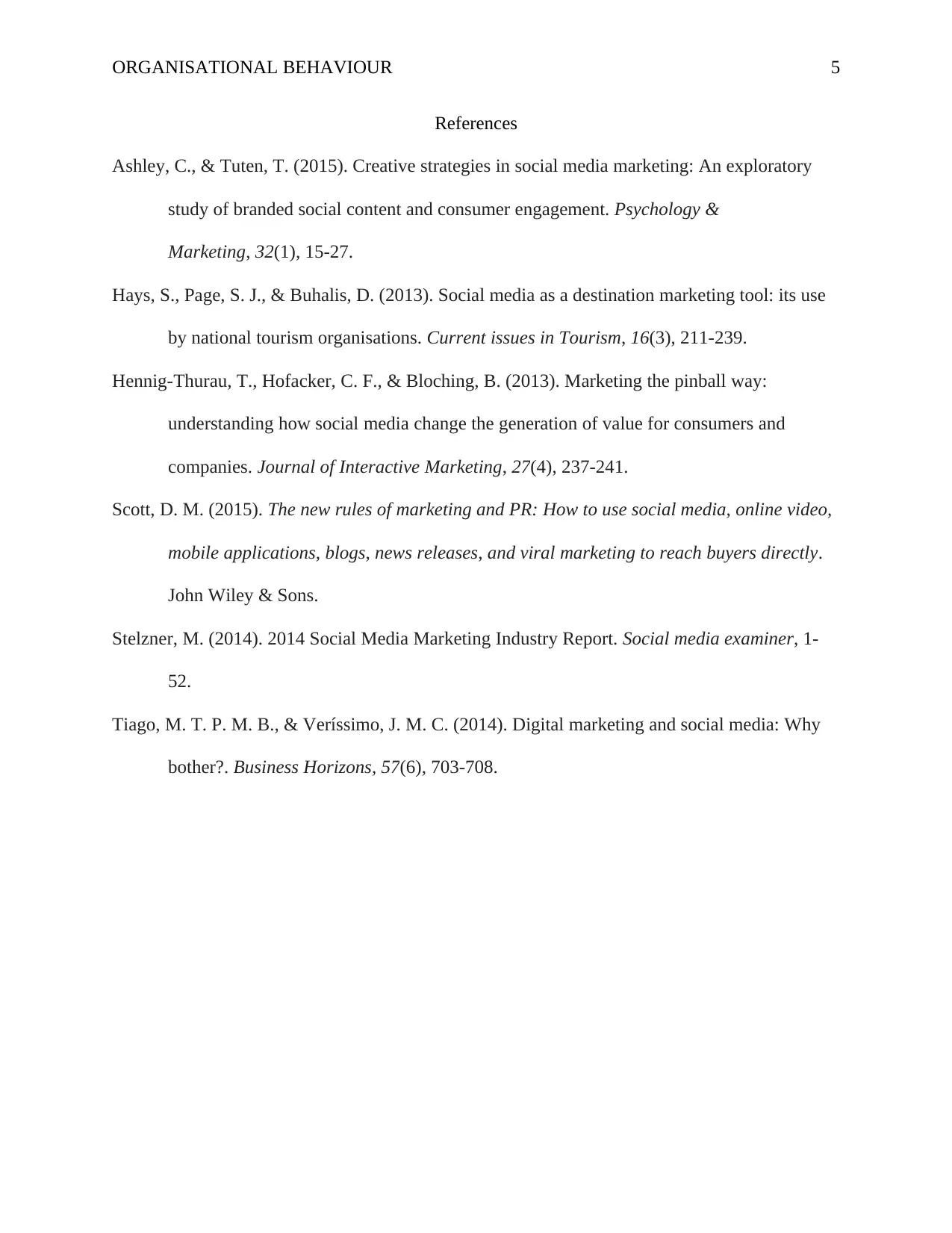
ORGANISATIONAL BEHAVIOUR 5
References
Ashley, C., & Tuten, T. (2015). Creative strategies in social media marketing: An exploratory
study of branded social content and consumer engagement. Psychology &
Marketing, 32(1), 15-27.
Hays, S., Page, S. J., & Buhalis, D. (2013). Social media as a destination marketing tool: its use
by national tourism organisations. Current issues in Tourism, 16(3), 211-239.
Hennig-Thurau, T., Hofacker, C. F., & Bloching, B. (2013). Marketing the pinball way:
understanding how social media change the generation of value for consumers and
companies. Journal of Interactive Marketing, 27(4), 237-241.
Scott, D. M. (2015). The new rules of marketing and PR: How to use social media, online video,
mobile applications, blogs, news releases, and viral marketing to reach buyers directly.
John Wiley & Sons.
Stelzner, M. (2014). 2014 Social Media Marketing Industry Report. Social media examiner, 1-
52.
Tiago, M. T. P. M. B., & Veríssimo, J. M. C. (2014). Digital marketing and social media: Why
bother?. Business Horizons, 57(6), 703-708.
References
Ashley, C., & Tuten, T. (2015). Creative strategies in social media marketing: An exploratory
study of branded social content and consumer engagement. Psychology &
Marketing, 32(1), 15-27.
Hays, S., Page, S. J., & Buhalis, D. (2013). Social media as a destination marketing tool: its use
by national tourism organisations. Current issues in Tourism, 16(3), 211-239.
Hennig-Thurau, T., Hofacker, C. F., & Bloching, B. (2013). Marketing the pinball way:
understanding how social media change the generation of value for consumers and
companies. Journal of Interactive Marketing, 27(4), 237-241.
Scott, D. M. (2015). The new rules of marketing and PR: How to use social media, online video,
mobile applications, blogs, news releases, and viral marketing to reach buyers directly.
John Wiley & Sons.
Stelzner, M. (2014). 2014 Social Media Marketing Industry Report. Social media examiner, 1-
52.
Tiago, M. T. P. M. B., & Veríssimo, J. M. C. (2014). Digital marketing and social media: Why
bother?. Business Horizons, 57(6), 703-708.
1 out of 5
Related Documents
Your All-in-One AI-Powered Toolkit for Academic Success.
+13062052269
info@desklib.com
Available 24*7 on WhatsApp / Email
![[object Object]](/_next/static/media/star-bottom.7253800d.svg)
Unlock your academic potential
Copyright © 2020–2025 A2Z Services. All Rights Reserved. Developed and managed by ZUCOL.





